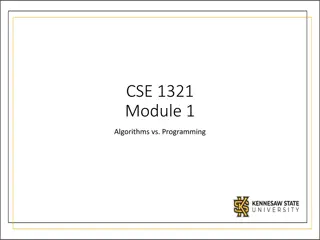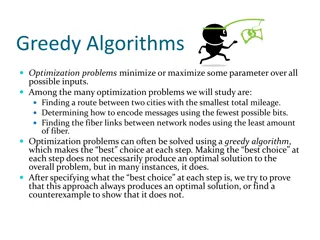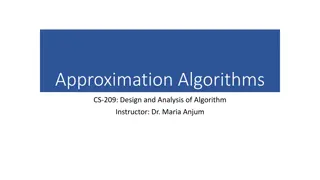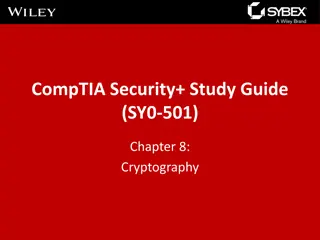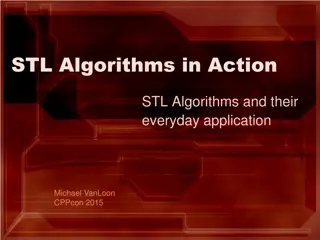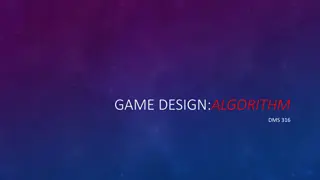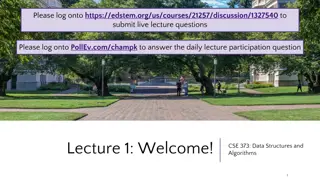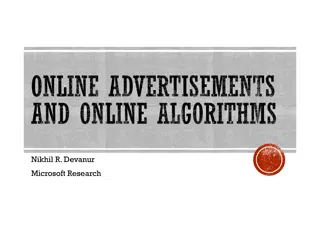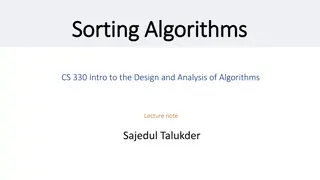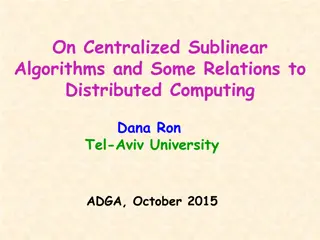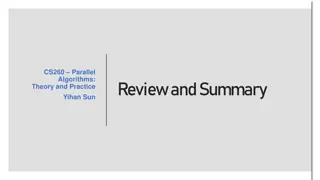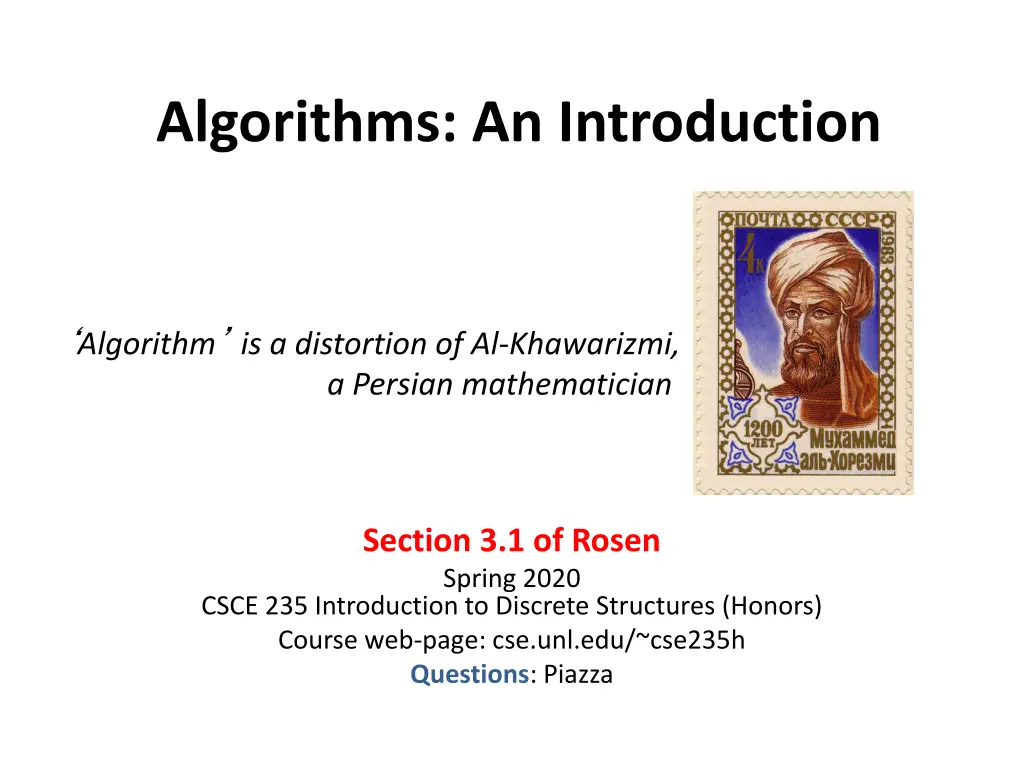
Understanding Algorithms and Their Types
Explore the introduction to algorithms, their categories, and types, including formal definitions, general techniques, and problem-solving strategies in computer science. Learn about designing algorithms, their properties, and various styles of algorithmic approaches.
Uploaded on | 1 Views
Download Presentation

Please find below an Image/Link to download the presentation.
The content on the website is provided AS IS for your information and personal use only. It may not be sold, licensed, or shared on other websites without obtaining consent from the author. If you encounter any issues during the download, it is possible that the publisher has removed the file from their server.
You are allowed to download the files provided on this website for personal or commercial use, subject to the condition that they are used lawfully. All files are the property of their respective owners.
The content on the website is provided AS IS for your information and personal use only. It may not be sold, licensed, or shared on other websites without obtaining consent from the author.
E N D
Presentation Transcript
Algorithms: An Introduction Algorithm is a distortion of Al-Khawarizmi, a Persian mathematician Section 3.1 of Rosen Spring 2020 CSCE 235 Introduction to Discrete Structures (Honors) Course web-page: cse.unl.edu/~cse235h Questions: Piazza
Outline Introduction & definition Algorithms categories & types Pseudo-code Designing an algorithm Example:Max Greedy Algorithms Change 2 CSCE 235 Algorithms: An Introduction
Computer Science is About Problem Solving A Problem is specified by 1. The givens (a formulation) A set of objects Relations between them 2. The query The information one wants to extract from the formulation, the question to answer Real World Computing World Objects represented by data Structures, ADTs, Classes Relations implemented with relations & functions (e.g., predicates) Actions Implemented with algorithms: a sequence of instructions An algorithm is a method or procedure that solves instances of a problem 3 CSCE 235 Algorithms: An Introduction
Algorithms: Formal Definition Definition: An algorithm is a sequence of unambiguous instructions for solving a problem. Properties of an algorithm Finite: the algorithm must eventually terminate Complete: Always give a solution when one exists Correct (sound): Always give a correct solution For an algorithm to be an acceptable solution to a problem, it must also be effective. That is, it must give a solution in a reasonable amount of time Efficient= runs in polynomial time. Thus, effective efficient There can be many algorithms to solve the same problem 4 CSCE 235 Algorithms: An Introduction
Outline Introduction & definition Algorithms categories & types Pseudo-code Designing an algorithm Example:Max Greedy Algorithms Change 5 CSCE 235 Algorithms: An Introduction
Algorithms: General Techniques There are many broad categories of algorithms Deterministic versus Randomized (e.g., Monte Carlo) Exact versus Approximation Sequential/serial versus Parallel, etc. Some general styles of algorithms include Brute force (enumerative techniques, exhaustive search) Divide & Conquer Transform & Conquer (reformulation) Greedy Techniques 6 CSCE 235 Algorithms: An Introduction
Outline Introduction & definition Algorithms categories & types Pseudo-code Designing an algorithm Example:Max Greedy Algorithms Change 7 CSCE 235 Algorithms: An Introduction
Good Pseudo-Code: Example Intersection Input: Two finite sets A, B Output: A finite set C such that C = A B 1. C 2. If |A|>|B| ThenSwap(A,B) 3. For everyx ADo 4. Ifx BThenC C {x} 5. End 6. ReturnC Union(C,{x}) 8 CSCE 235 Algorithms: An Introduction
Algorithms: Pseudo-Code Algorithms are usually presented using pseudo-code Bad pseudo-code Gives too many details or Is too implementation specific (i.e., actual C++ or Java code or giving every step of a sub-process such as set union) Good pseudo-code Is a balance between clarity and detail Abstracts the algorithm Makes good use of mathematical notation Is easy to read and Facilitates implementation (reproducible, does not hide away important information) 9 CSCE 235 Algorithms: An Introduction
Writing Pseudo-Code: Advice Input/output must properly defined All your variables must be properly initialized, introduced Variables are instantiated, assigned using All commands (while, if, repeat, begin, end) boldface \bf Fori 1 to nDo All functions in small caps Union(s,t) \sc All constants in courier: pi 3.14 \tt All variables in italic: temperature 78 \mathit{} LaTeX: Several algorithm formatting packages exist on WWW 10 CSCE 235 Algorithms: An Introduction
Outline Introduction & definition Algorithms categories & types Pseudo-code Designing an algorithm Example:Max Max Greedy Algorithms Change 11 CSCE 235 Algorithms: An Introduction
Designing an Algorithm A general approach to designing algorithms is as follows Understanding the problem, assess its difficulty Choose an approach (e.g., exact/approximate, deterministic/ probabilistic) (Choose appropriate data structures) Choose a strategy Prove 1. Termination 2. Completeness 3. Correctness/soundness Evaluate complexity Implement and test it Compare to other known approach and algorithms 12 CSCE 235 Algorithms: An Introduction
Algorithm Example: Max When designing an algorithm, we usually give a formal statement about the problem to solve Problem Given: a set A={a1,a2, ,an} of integers Question: find the index i of the maximum integer ai A straightforward idea is Simply store an initial maximum, say a1 Compare the stored maximum to every other integer in A Update the stored maximum if a new maximum is ever encountered 13 CSCE 235 Algorithms: An Introduction
Pseudo-code of Max Max Input: A finite set A={a1,a2, ,an}of integers Output: The largest element in the set 1. temp a1 2. For? 2to? Do 3. If??> ???? 4. Then???? ?? 5. End 6. End 7. Return???? 14 CSCE 235 Algorithms: An Introduction
Algorithms: Other Examples Check Bubble Sort and Insertion Sort in your textbooks which you should have seen ad nauseum in CSE 155 and CSE 156 And which you will see again in CSE 310 Let us know if you have any questions 15 CSCE 235 Algorithms: An Introduction
Outline Introduction & definition Algorithms categories & types Pseudo-code Designing an algorithm Example:Max Greedy Algorithms Change Change 16 CSCE 235 Algorithms: An Introduction
Greedy Algorithms In many problems, we wish to not only find a solution, but to find the best or optimal solution A simple technique that works for some optimization problems is called the greedy technique As the name suggests, we solve a problem by being greedy Choose what appears now to be the best choice Choose the most immediate best solution (i.e., think locally) Greedy algorithms Work well on some (simple) problems Usually they are not guaranteed to produce the best globally optimal solution 17 CSCE 235 Algorithms: An Introduction
Change-Making Problem We want to give change to a customer but we want to minimize the number of total coins we give them Problem Given: An integer n an a set of coin denominations (c1,c2, ,cr) with c1>c2> >cr Query: Find a set of coins d1,d2, ,dr such that ?=1 ????= ? and ?=1 ? ? ?? minimized 18 CSCE 235 Algorithms: An Introduction
Greedy Algorithm: Change Change Input: An integer n and a set of coin denominations {c1,c2, ,cr} with c1 > c2> >cr Output: A set of coins d1,d2, ,dr such that ?=1 1. For? 1 ?? ? Do 2. ?? 0 3. While? ?? Do 4. ?? ?? + 1 5. ? ? ?? 6. End 7. Return{??} ? ? ????= ?, ?=1 ?? minimized 19 CSCE 235 Algorithms: An Introduction
Change: Analysis (1) Will the algorithm always produce an optimal answer? Example Consider a coinage system where c1=20, c2=15, c3=7, c4=1 We want to give 22 cents in change What is the output of the algorithm? Is it optimal? It is not optimal because it would give us two c4 and one c1 (3 coins). The optimal change is one c2 and one c3 (2 coins) 20 CSCE 235 Algorithms: An Introduction
Optimality of Change (1) How about the US currency : c1=25, c2=10, c3=5, c4=1, is the algorithm correct in this case? Yes, in fact it is. We prove it by contradiction and need the following lemma If ? is a positive integer, then ? cents in change using quarters, dimes, nickels, and pennies using the fewest coins possible Has at most two dimes Has at most one nickel Has at most four pennies, and Cannot have two dimes and a nickel The amount of change in dimes, nickels, and pennies cannot exceed 24 cents 21 CSCE 235 Algorithms: An Introduction
Optimality of Change (2) Assume: q is the number of quarters returned by the greedy algorithm q is the number of quarters returned by the optimal solution Three cases: 1. ? > ?. The greedy algorithm chooses the largest number of quarters possible, by construction. Thus, it is impossible to q >q. 2. ? < ?. Since the greedy algorithms uses as many quarters as possible, ? = ?(25) + ?, where ? < 25. If ? < ?, then, ? = ? (25) + ? where ? 25. C will have to use more smaller coins to make up for the large r (see Lemma). Thus C is not the optimal solution. 3. ? = ? . then we continue the argument on the smaller denomination (e.g., dimes). Eventually, we reach a contradiction. Thus, the greedy algorithm gives the optimal solution 22 CSCE 235 Algorithms: An Introduction
Greedy Algorithm: Another Example Check the problem of Scenario I, page 25 in the slides IntroductiontoCSE235.ppt We discussed then (remember?) a greedy algorithm for accommodating the maximum number of customers. The algorithm terminates, is complete, sound, and satisfies the maximum number of customers (finds an optimal solution) runs in time linear in the number of customers 23 CSCE 235 Algorithms: An Introduction
Summary Introduction & definition Algorithms categories & types Pseudo-code Designing an algorithm Example: Max Greedy Algorithms Example: Change 24 CSCE 235 Algorithms: An Introduction

